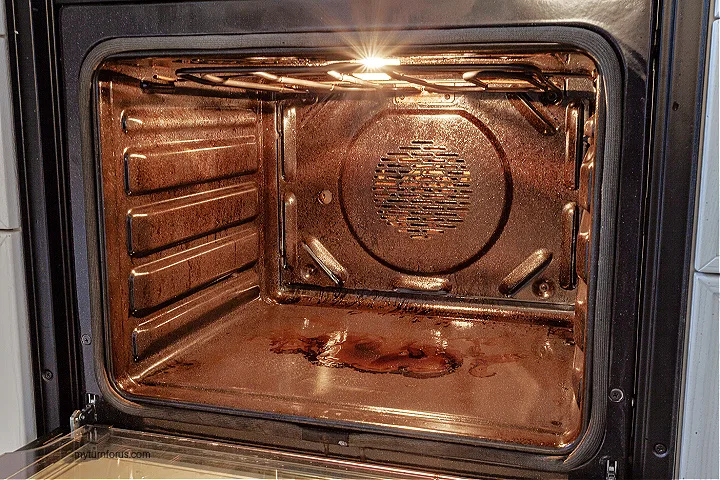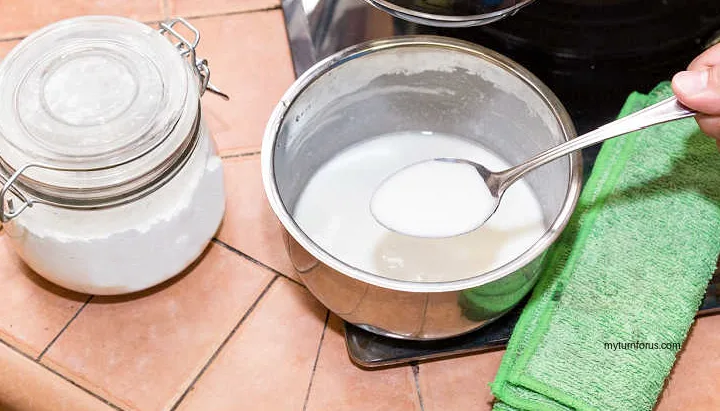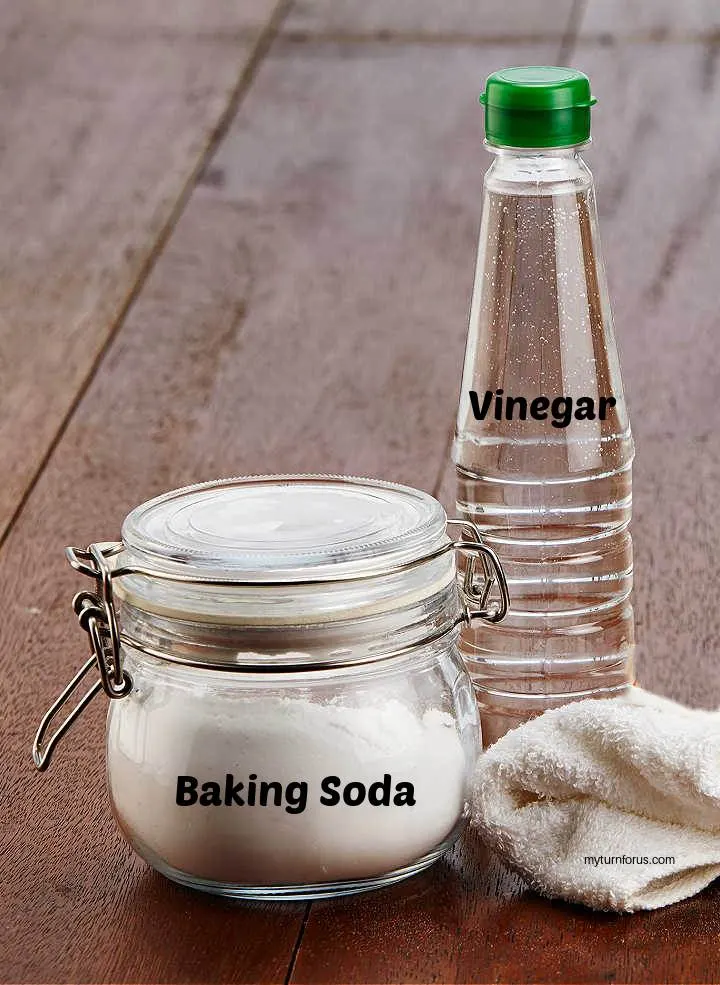Cleaning product made by mixing vinegar, lemon and baking soda for deep cleaning oven, cleaning grease from oven and inside oven door cleaner. Other uses for vinegar and baking soda and best house cleaning tools and equipment.

Deep cleaning oven is a chore that many people neglect, and it isn’t hard to see why. It’s difficult, messy, and generally very unpleasant. However, it’s a critical task when it comes to maintaining the quality and cleanliness of your kitchen.
This post contains affiliate links which means if you make a purchase we might recipe a small commission at no additional cost to you.

Deep clean your oven without the use of harsh chemicals. As long as you’re willing to put in a little elbow grease – and get takeout or stick to the stovetop for one or two meals – you’ll be pleased to see how clean your oven can get using this cleaning product made by mixing vinegar lemon and baking soda And then continue cleaning your home without chemicals using our simple tips on making your own cleaning products using safe ingredients.
Deep Cleaning Your Oven:

Allowing grease and grime to build up inside can cause your oven to smoke at higher temperatures. Aside from setting off your smoke alarm, an unclean oven can impart unwanted flavors into whatever you’re cooking.
Options for Cleaning grease from oven:
- Most ovens are equipped with a self-cleaning mode, which essentially locks the door, cranks the temperature up as high as it’ll go, and incinerates all of the grease and crumbs inside. This smells pretty bad and, again, can trigger your smoke alarm, so many people prefer to find an alternate solution.
- Cleaning companies know this, so they’ve made tons of chemical-filled products to help you remove the gunk from your oven. Unfortunately, these formulas can be quite harsh in terms of the chemicals they use and may not be something you want your family exposed to, either.
- Fortunately, there’s a way to clean your oven that involves no harsh chemicals at all. While a chemical-free oven cleaning will typically require a little more elbow grease and time than the solutions mentioned above, you won’t be forced to face the unpleasant odor of aggressive cleaners or the burning smell of your oven.

All you need to do is combined two common ingredients in your pantry – baking soda and white vinegar. These household ingredients, combined with a little elbow grease, can make an incredible difference in cleaning the dirtiest ovens.
How to make Non Toxic Oven Cleaner

Non Toxic Oven Cleaner Recipe:
Ingredients:
- 1 cup baking soda
- 4-5 teaspoons of white vinegar
Directions:
- Measure out the baking soda in a small bowl and slowly incorporate the white vinegar, one spoonful at a time.
- Aim for a paste-like consistency
Deep clean your oven with this non toxic oven cleaner recipe:

Make sure your oven is completely cooled. Then, remove everything inside, including the racks, and coat the inside of your oven with your baking soda paste. You can use a paintbrush or rubber spatula to spread it on the top, bottom, sides, and back, or you can put on a pair of gloves and apply using your hands. Cover all surfaces except for the heating elements.

After you have finished painting your oven with the baking soda paste, do the same with the racks. Make sure and cover all surfaces, the paintbrush comes in handy at this time. Then, let everything sit for 12-18 hours.

Once that time has passed, it’s time to finish the job. Start by using a damp paper towel or cloth to wipe down the surfaces, removing as much of the baking soda as you can.

Then, spray down the interior with white vinegar afterward to loosen the remaining paste before cleaning the rest off. If your oven is especially dirty, or you didn’t use enough of the baking soda paste the first time around, you may need to repeat the process.
Uses for Baking Soda and Vinegar other than deep cleaning your oven:

Uses of Baking Soda and Vinegar:
- Clogged Drains: Clean drain with Baking Soda by mixing one part of baking soda with two parts of vinegar. This mixture creatives a bubbling fizz action that cleans and freshen drains.
- Grease Stains: For Clothing: Test a small hidden spot first to make sure it is safe for that fabric. If it’s fine then soak the stain with a mix of one part water and one part white vinegar. Sprinkle more baking soda on the stain and rub it into the fabric. The vinegar will break down the grease and the baking soda will act as a mild abrasive to lift the stain. After stain is removed, wash your clothes as your normally do.
- Grout: Apply a paste made of baking soda and water with a small brush, an old toothbrush works well. Spray the paste with vinegar before scrubbing the grime away.
- Laundry: Kill mildew in laundry using baking soda and vinegar. Add a half a cup of baking soda along with your laundry detergent. Then during the rinse cycle, add one cup of vinegar to kill bacteria and soften fabric.
- Tarnished silver (tableware or jewelry): Mix ½ cup of white Vinegar with 2 Tablespoons of baking soda in a bowl of warm water. Place silver in bowl and let soak for 2-3 hours. Rinse with cold water and let air dry.
- Microwave: Combine baking soda and water in a microwave safe bowl. Turn microwave on for three to five minutes. Let set for a few minutes and then wipe it out. This mixture breaks down the tough stains and grease.
- Cleaning Shower Doors: Pour 1 cup of baking soda (bicarbonate of soda) and add ¼ cup of white vinegar to a small plastic bowl to make a paste. As soon as it stops fizzing, apply to glass shower doors and let set for 15 minutes and then scrub and rinse off completely. This can be used in the sliding glass door track by applying with an old toothbrush and allowing plenty of time for it to do its work. Rinse and dry well.
- Cleaning toilet bowls: Add one cup of baking soda to the toilet bowl. Pour in 1 cup white vinegar. The solution will fizz up. Put the lid down and allow it to work for 30 minutes minutes and then scrub the bowl with a toilet brush and flush.
Cleaning product made by mixing vinegar, lemon and baking soda:

Cleaning Product Recipe made by mixing vinegar, lemon and baking soda
Ingredients:
- ¼ cup white vinegar
- 2 Tablespoons baking soda
- 4 cups hot water
- ½ lemon
Instructions:
- In a small bucket or large Pyrex measuring cup, combine vinegar, baking soda and hot water.
- Squeeze and add the juice from half a lemon and drop the rind in as well.
- Stir well to dissolve the baking soda and allow your cleaning product to cool. Remove the lemon rind.
- Transfer into a spray bottle or squeeze bottle and use immediately. It works better if used as soon as possible after mixing.
Use this Cleaning Product made by mixing vinegar, lemon and baking soda for:
- Wiping down Countertops
- Cleaning the front of the microwave
- Wiping down Refrigerator Door
- Cleaning Bathroom Tub
- Bathroom Sinks
Baking Soda (bicarbonate of soda) for cleaning

Uses for Baking Soda:
- Clean drains with Baking Soda: if you do not wish to add vinegar with the baking soda to your drain, then you can add one cup baking soda to the drain and follow up with ½ cup salt. Let set overnight and in the morning, flush with 2 cups boiling water.
- For countertops, linoleum, the stovetop and pots and pans; mix 3 tablespoons of baking soda with 1 cup of water. Use the solution on a sponge to scrub away light grease stains from hard surfaces.
- Microwave: Combine 2 tablespoons baking soda and one cup of water in a microwave safe bowl. Microwave for 3 minutes (no cover on bowl) and let set in closed microwave for 15 minutes. Carefully remove the hot bowl and wipe down the inside of the microwave.
- Polish Marble with Baking Soda: Sprinkle a a lite dusting of baking soda on the marble. Gently rub with a soft cloth, never use scrubbing brushes or anything abrasive. Rinse the marble with water and dry with a soft towel as soon as possible. Do not leave the baking soda on the marble for any length of time as it can damage. Even light abrasives can damage marble surfaces. Be sure that all the baking soda is rinse off well.
- Use Baking Soda on a damp Cloth: Sprinkle a little baking soda on a damp cloth and wipe down surfaces for everyday cleaning
- Inside Oven Door Cleaner: Open oven door and wipe off the surface. Pour baking soda into a small bowl and add enough water to make a paste. Spread the paste all around the inside oven door including the window. Let set for 15 -20 minutes and wipe away with a clean damp cloth.
-
Refrigerator: Wipe the inside with a mixture of 2 tablespoons baking soda and 1 quart hot water. Rinse with a clean damp cloth and then dry. This mixture will clean and help eliminate orders Never use soap or detergent because they will leave behind orders the food can absorb. Remove caked-on residue, apply the baking soda solution with a wet towel. Leave the door open, and let the residue soak in the solution for 10 minutes, or until it starts to crack or soften. Reapply if necessary and then wipe clean.
Reasons to use Baking Soda (bicarbonate of soda) for cleaning
- It is very inexpensive
- A very safe and effective sanitizer
- Removes stains
- Deodorizes
- Contains no harsh chemicals
- Less likely to harm surfaces like harsher chemicals such as vinegar, ammonia, dishwashing liquid, or detergents
Other Uses for a White Vinegar Cleaning Solution:

Ways to Clean with White Vinegar:
- Microwave: Combine vinegar and water in a heatproof bowl. Then, heat the mixture for three to five minutes and leave door closed for 3-4 minutes. Use a damp cloth and wipe the microwave down.
- How to clean tiles with vinegar: Combine ½ cup of vinegar with one gallon hot water and mix well. Sweep tile floors to remove any dust or small particles that could scratch. Mop the entire floor with the vinegar water mixture and allow to dry. Cleaning bathroom with vinegar you could use a sponge to clean wall tiles and countertops.
- Descaling solution vinegar for Coffee Maker: Rinse the coffee pot or carafe and dispose of any coffee grounds. Fill the water reservoir halfway with white vinegar and fill the remaining with clean water. With the carafe or coffee pot in place, start a brew cycle. Halfway thru the cycle, stop it by turning the coffee maker off or unplugging it. Let sit for about an hour. Then finish the brew cycle and pour out the solution from the coffee pot. Fill the water reservoir with clean water and run another brew cycle, disposing of the water afterwards. Repeat this two more times to thoroughly remove any remains of the vinegar or scale debris from your coffee maker.
- Cleaning and descaling solution for Keurig Coffee Maker: Wipe the surface of your machine with a damp cloth including any removable parts. Fill the water reservoir halfway with vinegar and the rest of the way with water. Brew without a k-cup discarding the water until the reservoir is empty. Rinse well and fill with clean water and repeat until the reservoir is empty discarding the cups of water to remove any vinegar taste.
- Multi Purpose Cleaner: Fill ⅓ of a spray bottle with white vinegar and fill the rest with water. You could also add three to five drops of your favorite essential oil mask the vinegar smell but the smell of vinegar does dissipate quickly.
- Vinegar for Window Cleaning: Fill ⅓ of a spray bottle with white vinegar and fill the rest with water and use on any glass surfaces. Or you can bring it up a notch and make a mixture of ¼ cup of white vinegar, 2 ½ cups of water plus ½ teaspoon of dish soap. You will need to rinse the windows afterwards to remove any suds residue but this mixture is the bomb when it comes to clean windows. For added convenience use a squeegee which comes in several sizes.
- Mop with Vinegar: Mix ½ cup of vinegar with one gallon of hot water for mopping. Wring out the mop thoroughly so it is only damp and doesn’t saturate wood floors.
Click HERE to save this Cleaning product made by mixing vinegar lemon and baking soda to Pinterest:
House Cleaning Tools and Equipment
This is our list of our best house cleaning tools and equipment that is tried and true and we use around our house.
O-Cedar EasyWring Microfiber Spin Mop, Bucket Floor Cleaning System- with built-in wringer that allows for hands-free wringing. The EasyWring Microfiber Mop Head is machine-washable and reusable. Safe for all hard flooring, including finished hardwood, wood, laminate, tile, vinyl and more.
Swiffer Dusters 360 Extendable Handle Starter Kit with 4 Refills-, Swiffer Dusters 360° extendable handle traps and locks up to 3x more dust and allergens* than a feather duster. The extendable handle extends up to 3 feet for ceilings and ceiling fans.
Heavy Duty Spraying Bottles Leak Proof Mist Empty Water Bottle for Cleaning Solution Planting Pet with Adjustable Nozzle and Measurements-(4 Pack, 24 Oz, All-Purpose)
Amber Glass Spray Bottle Set & Accessories Combo Pack:
2 spray bottles (16oz) 2 Black Trigger nozzles; 2 Black Glass Lids; 4 Black Labels; 1 Marker; 1 Brush.
In addition to being easily recycled, the amber glass spray bottles protect the environment and reduce plastic chemicals in your house ,The BPA-free materials keep your families safe from excess chemicals as well.
- Easily clean shower doors, windows, tile, mirrors, bathroom, kitchen, decks, patios, and many other surfaces with this versatile squeegee. This squeegee shower cleaner comes with a 10-inch wide rubber blade, an ergonomic design, and a lightweight handle.
- EASY TO USE & STORE: Complete with a set of waterproof adhesive hooks, the shower squeegee can be stored almost anywhere for quick access and easy use.
Dry Rite's Best Magic Microfiber Cloth - Professional Series Cleaning Towels for Kitchen, Bath, Auto Detailing, TV, Glass, Mirrors - No Scratch, Lint and Streak Free. Use Wet/Dry 12"x12" 1 Dozen
O-Cedar Pet Pro Broom & Step-On Dustpan cleans 99% of dust, dirt, and hair in one sweep with V-shaped bristles for better floor contact while the angled broom head makes accessing corners a breeze
Our step-on dust pan's integrated cleaning combs allow you to remove three times more hair without using your hands. The dust pan is made with antistatic technology allowing debris to release into the trash with a tap
Mr. Clean Magic Eraser, Extra Durable Pro Version, Shoe, Bathroom, and Shower Cleaner, Cleaning Pads
- This cleaning scrubber is tough on dirt, all around the house! Surface cleaner, wall cleaner, bathtub cleaner, bathroom cleaner, oven door cleaner, erases marks on light switches, doors & much more!
- Great for sneaker shoe cleaning. Mr. Clean Magic Erasers tackle tough marks, stuck-on dirt and scuffs to get your shoes looking like new.
- The Mr. Clean Magic Eraser provides a powerful clean with water alone. No harsh chemicals added. Store in a cool place.
Multipurpose Kitchen Scrub Sponges, Heavy Duty Cleaning Non-Scratch Scrub Sponge, Reusable Microfiber Sponge for Household Cleaning, Pack of 5 Colors with a Hook.
- Textured scrubber on one side; soft, scratch-free, and absorbent on the other.
- High density inner sponge with superior absorption leaves no marks after use. These sponges are built to last and are 100% washer and dryer safe for easy cleaning.
- The tough kitchen scrub sponges contain no harmful chemicals. For the health and safety of our customers, we ensure that our sponges are 100% safe to use.
Other Helps for Cleaning and Organizing your Home:
- Organize your Pantry
- Alternative Ingredients and Simple Kitchen Tips
- Homemade Fire Starters from Dryer Lint
- Mini Hand Sanitizers











